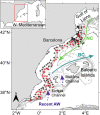Spatial heterogeneity of Pelagia noctiluca ephyrae linked to water masses in the Western Mediterranean
- PMID: 33826668
- PMCID: PMC8026071
- DOI: 10.1371/journal.pone.0249756
Spatial heterogeneity of Pelagia noctiluca ephyrae linked to water masses in the Western Mediterranean
Abstract
Pelagia noctiluca is the most common jellyfish in the Western Mediterranean Sea, living in oceanic waters with a holoplanktonic lifecycle. Frequent outbreaks have been well documented in coastal areas, yet little is known about their offshore distribution. In this study we address the relationship between oceanographic structures and the distribution of P. noctiluca ephyrae along the central continental slope of the Western Mediterranean, covering a wide latitudinal gradient, during July-August 2016. The region is characterized by a rich and complex mesoscale surface circulation driven by the inflow of Atlantic Water into the Western Mediterranean through the Strait of Gibraltar. The results revealed a high variability in the ephyrae spatial paterns related with different water masses and the resulting mesoscale hydrographic features. Their horizontal distribution showed a clear latitudinal gradient with high abundances in the south, associated with recent Atlantic Water, and low abundances or absence in the north, in coincidence with the old Atlantic Water transported by the Northern Current. Ephyrae showed diel vertical migrations of short-extent in the first 50 m, with a wide distribution above the thermocline and the Deep Chlorophyll Maximum during daytime, being more concentrated towards the surface at night. The results suggest the population connectivity of P. noctiluca between the Atlantic and the Mediterranean. In that case, the abundance variability of the species in the Mediterranean could be modulated by its entrance associated with the inflow of Atlantic Water through the Strait of Gibraltar.
Conflict of interest statement
The authors have declared that no competing interests exist.
Figures








References
-
- Condon RH, Graham WM, Duarte CM, Pitt KA, Lucas CH, Haddock SHD, et al.. Questioning the Rise of Gelatinous Zooplankton in the World’s Oceans. Bioscience. 2012;62(2):160–9.
-
- Purcell JE, Uye S, Lo W. Anthropogenic causes of jellyfish blooms and their direct consequences for humans: a review. Mar Ecol Prog Ser. 2007;350:153–74.
-
- Brotz L, Cheung WWL, Kleisner K, Pakhomov E, Pauly D. Increasing jellyfish populations: trends in Large Marine Ecosystems. Hydrobiologia. 2012;690(1):3–20.
Publication types
MeSH terms
Substances
LinkOut - more resources
Full Text Sources
Other Literature Sources

